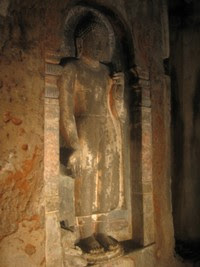 Ajanta Caves (Devanagari:अजंठा लेणी) in Maharashtra, India are rock-cut cave monuments dating from the second century BCE, containing paintings and sculpture considered to be masterpieces of both “Buddhist religious art” and “universal pictorial art”. The caves are located just outside the village of Ajinha in Aurangabad District in the Indian state of Maharashtra (N. lat. 20 deg. 30′ by E. long. 75 deg. 40′). Since 1983, the Ajanta Caves have been a UNESCO World Heritage Site. A National Geographic edition reads, “The flow between faiths was such that for hundreds of years, almost all Buddhist temples, including the ones at Ajanta, were built under the rule and patronage of Hindu kings.”
Ajanta Caves (Devanagari:अजंठा लेणी) in Maharashtra, India are rock-cut cave monuments dating from the second century BCE, containing paintings and sculpture considered to be masterpieces of both “Buddhist religious art” and “universal pictorial art”. The caves are located just outside the village of Ajinha in Aurangabad District in the Indian state of Maharashtra (N. lat. 20 deg. 30′ by E. long. 75 deg. 40′). Since 1983, the Ajanta Caves have been a UNESCO World Heritage Site. A National Geographic edition reads, “The flow between faiths was such that for hundreds of years, almost all Buddhist temples, including the ones at Ajanta, were built under the rule and patronage of Hindu kings.”

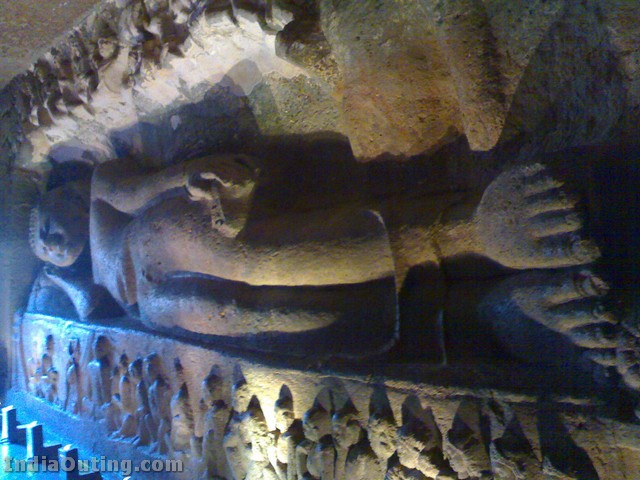

Get In
The caves are in a wooded and rugged horseshoe-shaped ravine about 3½ km from the village of Ajantha. It is situated in the Aurangābād district of Maharashtra State in India (106 kilometers away from the city of Aurangabad). The nearest towns are Jalgaon (60 kilometers away) and Bhusawal (70 kilometers away). Along the bottom of the ravine runs the river Waghur, a mountain stream. There are 29 caves (as officially numbered by the Archaeological Survey of India), excavated in the south side of the precipitous scarp made by the cutting of the ravine. They vary from 35 to 110 ft (34 m) in elevation above the bed of the stream.
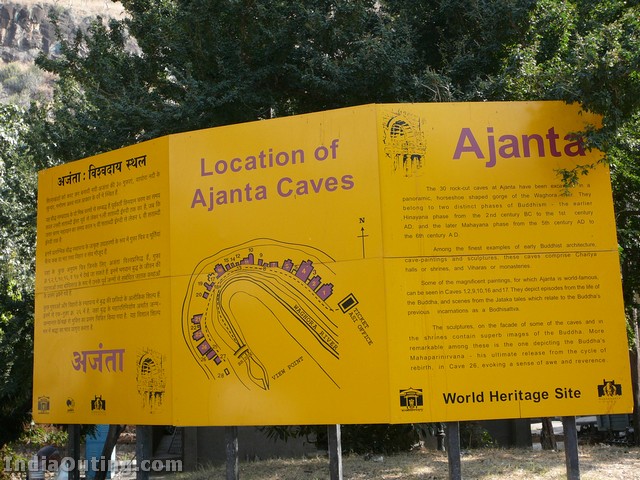
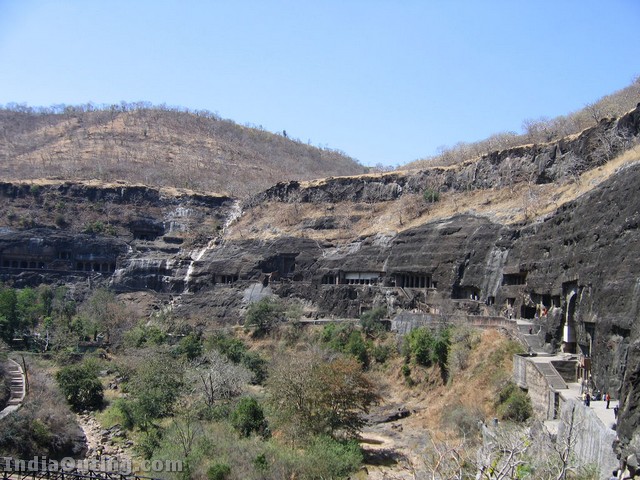

History
The monastic complex of Ajanta consists of several viharas (monastic halls of residence) and chaitya-grihas (stupa monument halls) cut into the mountain scarp in two phases. The first phase is mistakenly called the Hinayana phase (referring to the Lesser Vehicle tradition of Buddhism, when the Buddha was revered symbolically). Actually, Hinayana – a derogative term for Sthaviravada – does not object to Buddha statues. At Ajanta, cave numbers 9, 10, 12, 13, and 15A (the last one was re-discovered in 1956, and is still not officially numbered) were excavated during this phase. These excavations have enshrined the Buddha in the form of the stupa, or mound.
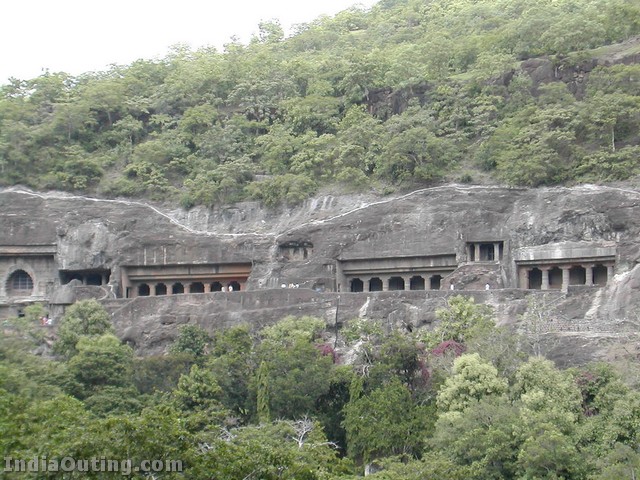
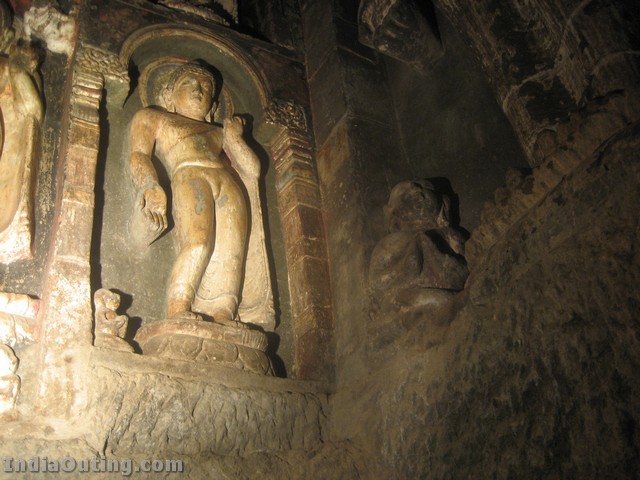
By AD 480 the caves at Ajanta were abandoned. During the next 1300 years the jungle grew back and the caves were hidden, unvisited and undisturbed until the Spring of 1819 when a British officer in the Madras army entered the steep gorge on the trail of a tiger. Somehow, deep within the tangled undergrowth, he came across the almost hidden entrance to one of the caves. Exploring that first cave, long since a home to nothing more than birds and bats and a lair for other, larger, animals, Captain Smith wrote his name in pencil on one of the walls. Still faintly visible, it records his name and the date, April 1819.
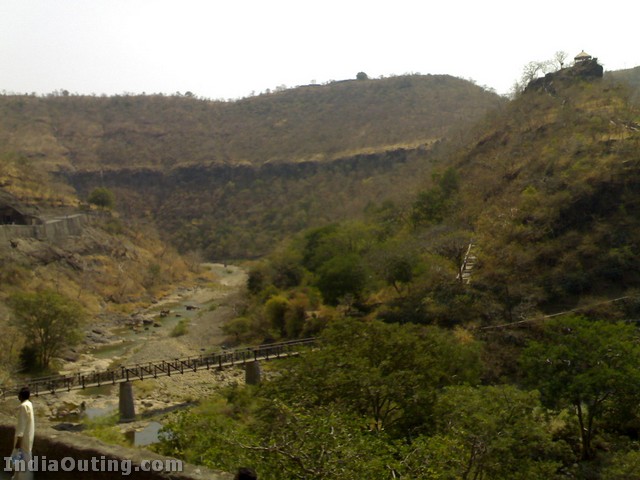
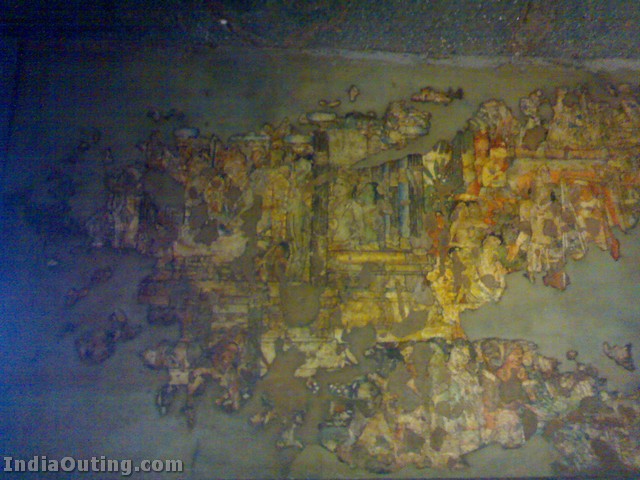
Paintings
Paintings are all over the cave except for the floor. At various places the art work has become eroded due to decay and human interference. Therefore, many areas of the painted walls, ceilings, and pillars are fragmentary. The painted narratives of the Jataka tales are depicted only on the walls, which demanded the special attention of the devotee. The process of painting involved several stages. The first step was to chisel the rock surface, to make it rough enough to hold the plaster. The plaster was made of clay, hay, dung and lime. Differences are found in the ingredients and their proportions from cave to cave. While the plaster was still wet, the drawings were done and the colors applied. The wet plaster had the capacity to soak the color so that the color became a part of the surface and would not peel off or decay easily.
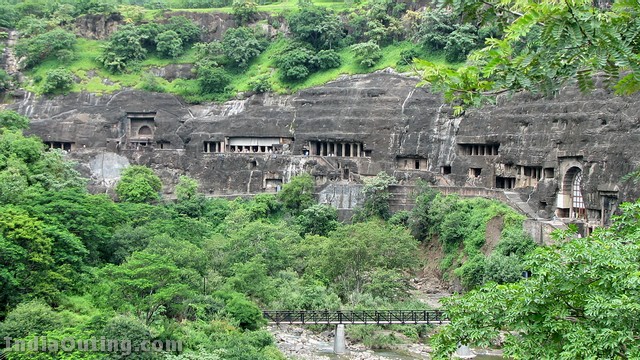
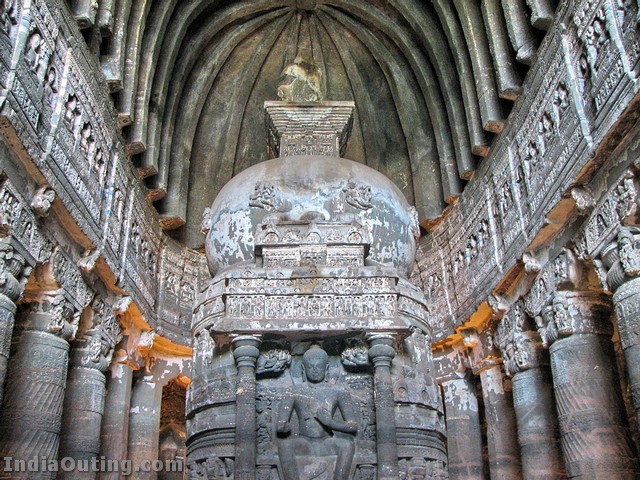
The colors were referred to as ‘earth colors’ or ‘vegetable colors.’ Various kinds of stones, minerals, and plants were used in combinations to prepare different colors. Sculptures were often covered with stucco to give them a fine finish and lustrous polish. The stucco had the ingredients of lime and powdered seashell or conch. The latter afforded exceptional shine and smoothness. In cave upper six, some of it is extant. The smoothness resembles the surface of glass. The paint brushes used to create the artwork were made from animal hair and twigs.
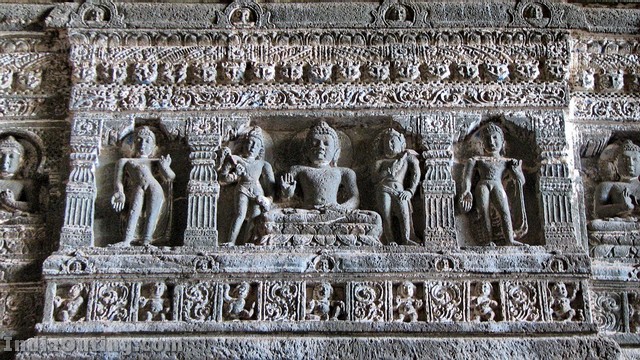
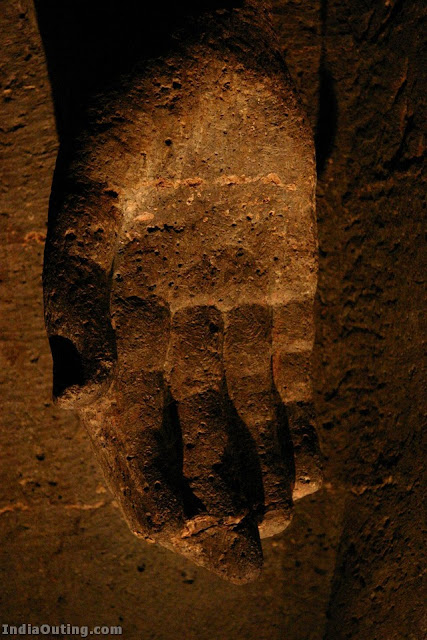
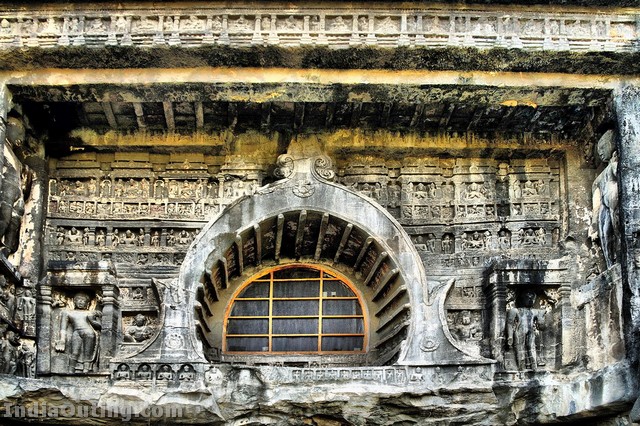

nice n beautiful .
ajanta caves i heard but i never seen before
in spite of visiting u show me the entire buddha statues of ajanta.
nor i like it or hate it but i love it
excellent,the history given along with pictures is very very useful and interesting.pl keep up.
manavi kala ka sarvottam namuna hai. jo hame hamara sanskrutik varsa dikhata hai.pathorope kiya gaya ye kala ka kam pathorome me jaan (life)dalane ke barabar hai amazing heven on earth
What A Beautiful Caves
I have personally seen Ajanta Caves long back. While seeing above photos I remembered
that day.
wonderful,
this is very beautiful & natural photos,
thank u to present this photos in net
thanks for you kind information
very very useful.
very super
Wow! Very impressive indeed. It is definately a test of human endevour and faith!
India’s heritage
wow beautiful place….nice pics.!!!
THIS IS UNBELIVEABLE FOR ME THAT SOMEBODY CREATED ALL THESE ON MOUNTENS
very beautyful place.
What a marvellous..Is it done by human!
A man made wonder. Seems to be built by only dedicated workmen.
It’s a very beautifull.
Depicts India’s rich heritage of that time. You will not believing without seeing…. Marvellous yet most beautiful scalapture.
Thank you. Bring out all about incredible India.
good work. Incredible India. Thanks for the show.
Indian Mans intelligence
Its amaging , Teach to others and Its wonders
very nice & there is no words
Great collection of pics, It entices the reader to visit these amazing caves and understand beauty of indian art.
hy it was quite good….thanks for sending such nice set of our culture …proud to b n indian……
excellent,the history given along with pictures is very very useful and interesting.pl keep up.
Dears…
It is one of the oldest manuments in this world- I think…! But we are not giving proper important to this place and try to rejuvenate it…? Are you accept me…? Thank you all..!
really interesting.
nice
this is the place for which we should really proud to be a indian…..
It is our Herritage, now we are hindu , muslim but Buddhism is the great natural Doctrine, if we have to follow the way of the buddha i think we are the great nation in the world
whatever i say wud seem an understatement…..u dun hav words fr praising certain things..
Wow! Really a great opportunity to surff thro’ the birds eye view of
ICE LAND.The contribution is remarkable beyond words.
regards
geetee
[email protected]
[email protected]
Very interesting,wish could visit.From Pakistan
salute sir for give me nice collection of ajanta
Hai,
very nice,
good work. Incredible India. Thanks for the show.
enjoy, long live,
thanks
its really wonder! exceelent and wonderful historical events given and shown.
hi muzammil
One has to visit AJINTHA at least once in a life time.
It is magnificent beyond words.
Peter Drucker said that it is a wonder of management art.
Management and Beauty :: A DUGDHA_SHARKARA_YOGA.
There are other wonderful monuments around.
Verul / Ellora , the ancestral town of Chhatrapati Shivaji.
Ghrishneswar JYOTIRLINGA Temple.
KAILAS LENI & Shiva Temple. ” Adhi Kalasa Maga Payaa”
ajanta yellora are the beautiful places that every budy should visit and see the beautiful curving done on rocks
I am from Dhaka, Bangladesh.
Firstly Thanks a lot to IndiaOutgonig Team.
Because the cave or scaplture show in front of people through net.
waw nice
nice
this is real Indian culture
excellent art & architecutre as well as location,once visit must
It is worth TREASURING –Great
WOW!!, What can one say!!, India the land of God!!
Thanks for shareing these wonderful Photo,s in all its splender.
Om Sai Ram
Siobhan.
IT IS A GREAT ARTWORK OF ANCIENT DAYS.
excellent
i love my india & indian history
maathi manus ahe maharashtrat ahe ajantha bihar madhi nahi
It is very beautiful creation by man, during the days without any advanced technology, but I hope they might have used other techniques to find out the location, properties of stone, design & execution which we should be able to find out & adopt in our present technology & take the benefit.
Marvelous and beautiful sculpture How have they done those days without any modern equipment and technology Really Amazing Hats oFf to those who had made it possible
its really very nice and historical place in our India.We all are proud for that.All work took thousands of years and generations,they worked over here by heart mind and by soul.We all must salute there hard work and beautiful outstanding work.I heartly gives thanks to all of those people who all decorate our India by carving beauty.Hats off for them…thanks thanks very much.
Really Very good collection
India is great
Thank you for your wonderful Presenation of Ajantha caves which I have visted in the year 1984 with my family.I would request you to give a presentation of Ellora caves also.
worth to see in our life time
Thanx,
Its different and perhaps nicer to see photgraphs– having seen it in person!
Good pictures
nice 2 see proud f my nation…
Dear Sir,The caves proved that our ancestors were abole to see(Dharsan)The almighty that is GOD.Thanks.krvsraoo
Its a fantastic outstanding & mindblowing.
excellent article and photos. to have created such a masterpiece in this dense jungle is amazing.
Its very beautiful and marvelous.I had visited once & again willing to go there.
Really a very remarkable set of Indian culture. Thanks for such type of massage.
really great pics.
very nice.one should make out time to visit it.
It is wonderful and remarkeble to vist the old monuments
Moti Manot
ONE YEAR BEFOR I VISIT TO THIS AJANTA CAVE ,THATS WHY I KNOW EVERYTHING CLEARLLY AND ALL THE THING SHOWN IN THIS PHOTO
adbhut asadharan
excellent,the history given along with pictures is very very useful and interesting, thanks for the kind information
its great architecture
Very Nice.
Simply superb.
hey its very nice
My visit to the Caves seven years ago left me with a sense of disappointment over the manner in which this historic place was being neglected as a heritage venue……
symbol of ancient intellectual-marvellous
It is a proud of india.
For a long time wondered why no news about these ?
Very informative
Its art of indian culture. the great artist works a long time and creat world class beauty
great,
its a world herietage site in india,we maintain & protect them, i proud that it is in india.
Great dedication devotion and understanding of the concept of Buddhism is very clearly explained here among ancient Indian people with their artistic talents.
Its a fantastic and outstanding. its a great architecture.
I have been twice there. Exellent. Must visit.
so…. wanderful it is proud of maharashtra
natuerlich sehr grossartig und Muehsam von inder ,auch von Bhudismus sehr klar in die Erklaerung.
its very helpfull